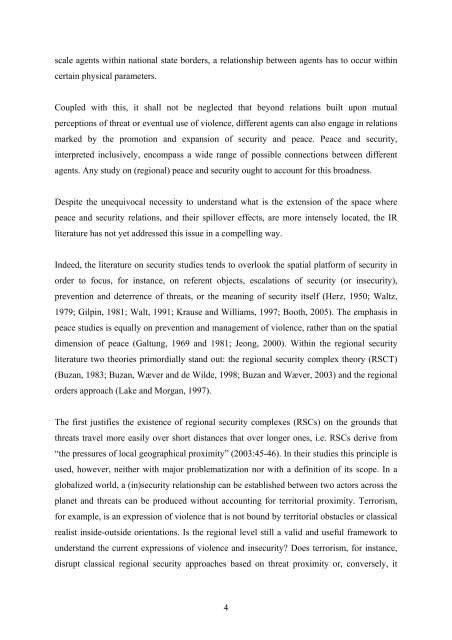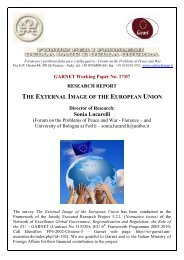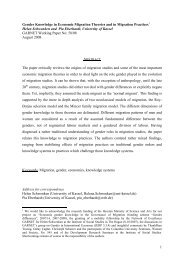GARNET Working Paper No. 13/07
GARNET Working Paper No. 13/07
GARNET Working Paper No. 13/07
Create successful ePaper yourself
Turn your PDF publications into a flip-book with our unique Google optimized e-Paper software.
scale agents within national state borders, a relationship between agents has to occur within<br />
certain physical parameters.<br />
Coupled with this, it shall not be neglected that beyond relations built upon mutual<br />
perceptions of threat or eventual use of violence, different agents can also engage in relations<br />
marked by the promotion and expansion of security and peace. Peace and security,<br />
interpreted inclusively, encompass a wide range of possible connections between different<br />
agents. Any study on (regional) peace and security ought to account for this broadness.<br />
Despite the unequivocal necessity to understand what is the extension of the space where<br />
peace and security relations, and their spillover effects, are more intensely located, the IR<br />
literature has not yet addressed this issue in a compelling way.<br />
Indeed, the literature on security studies tends to overlook the spatial platform of security in<br />
order to focus, for instance, on referent objects, escalations of security (or insecurity),<br />
prevention and deterrence of threats, or the meaning of security itself (Herz, 1950; Waltz,<br />
1979; Gilpin, 1981; Walt, 1991; Krause and Williams, 1997; Booth, 2005). The emphasis in<br />
peace studies is equally on prevention and management of violence, rather than on the spatial<br />
dimension of peace (Galtung, 1969 and 1981; Jeong, 2000). Within the regional security<br />
literature two theories primordially stand out: the regional security complex theory (RSCT)<br />
(Buzan, 1983; Buzan, Wæver and de Wilde, 1998; Buzan and Wæver, 2003) and the regional<br />
orders approach (Lake and Morgan, 1997).<br />
The first justifies the existence of regional security complexes (RSCs) on the grounds that<br />
threats travel more easily over short distances that over longer ones, i.e. RSCs derive from<br />
“the pressures of local geographical proximity” (2003:45-46). In their studies this principle is<br />
used, however, neither with major problematization nor with a definition of its scope. In a<br />
globalized world, a (in)security relationship can be established between two actors across the<br />
planet and threats can be produced without accounting for territorial proximity. Terrorism,<br />
for example, is an expression of violence that is not bound by territorial obstacles or classical<br />
realist inside-outside orientations. Is the regional level still a valid and useful framework to<br />
understand the current expressions of violence and insecurity Does terrorism, for instance,<br />
disrupt classical regional security approaches based on threat proximity or, conversely, it<br />
4





